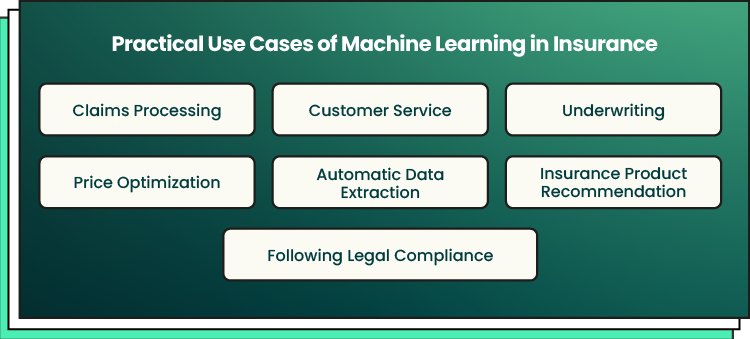Allied Market Research reports that the global AI in the insurance market was valued at $2,74 trillion in 2021. They project it to reach $19,66 billion by 2028. What’s more, the annual growth rate is predicted to be over 32,5%. Sounds promising, right?

But why is integrating machine learning in insurance so popular? First, ML technology aids in claims processing by automating operations. Compared to manual claims management, companies can work faster and more efficiently. Second, machine learning insurance improves customer service by offering more personalized solutions. That’s why many businesses opt for machine learning, exploring new practices and opportunities.
So, how does machine learning in insurance look today? How is it applied, and what trends and challenges does it bring? We will cover that further down, so keep reading.
The Insurance Market Size: Exploring Perspectives for Growth
As mentioned, the insurance market is skyrocketing without showing any signs of slowing down. According to Statista, the global insurance market has reached almost $6 and is projected to exceed $8 trillion by 2026. But is it really worth the candle to join a market filled with such fierce competition?
To answer this and similar questions, let’s explore the reasons and perspectives for the insurance market’s growth.
Today, insurance companies are shifting from the traditional business model due to significant manual work. By using technologies like machine learning insurance, they transform into insurtech companies. What’s more, by blending technology with AI and data science, these businesses become more successful and efficient.
AI in insurance, mainly machine learning, is a driving force behind the industry’s growth. More and more companies are using artificial intelligence to handle big data instead of relying on manual processing. Others integrate AI into risk prediction platforms to better secure clients’ assets and prevent losses.
It isn’t surprising that many companies have already digitized claims processing, like top insurtech players Next Insurance, Zipari, MetroMile, and Corvus Insurance. They inspire emerging startups to start with digitalization and AI automation. These companies take advantage of the latest technologies and easily outperform their rivals.
So, the tremendous growth of the insurance market is the outcome of enhanced digitalization. Integrating AI and advanced analytics provides a bright future for the insurance area and paves the way for innovations. Now, let’s focus on machine learning in insurance and the situations requiring its application.
Drivers of Machine Learning in Insurance
At present, insurers face numerous challenges. First, they invest much time and resources in manual claims processing. As a result, this decreases their operational efficiency. Second, insurers must analyze large datasets to find out mistakes or frauds. This step is crucial for making more informed decisions.
Modern insurers opt for machine learning for a bunch of reasons:
- Tons of information. The insurance industry is bombarded by the growing volume of data from various sources. These are claims, customer transactions, market trends, and emerging technologies. That’s why insurers are adopting machine learning to efficiently manage, process, and analyze this data.
- Strong need for automated solutions. Insurance processes are complex and challenging. They require a shift from manual to automated work. Automation can enhance speed, accuracy, and efficiency. Insurers opt for ML to streamline claims processing, enhance underwriting, and better respond to clients’ requests. Integrating machine learning insurance assists in addressing the challenges of a dynamic and data-rich insurance environment.
- Personalized customer experience. The competition in insurance is fierce, and companies are fighting for every client in diverse ways. One of the most efficient is the delivery of personalized services. Insurers have to talk with their customers to reveal their behaviors and needs. And of course, this is time-consuming. Machine learning in insurance makes this easier by enabling customized approaches.
- Enhanced risk assessment. As risk assessment is a vital aspect of insurance services, there is a strong need for improvement. That’s why insurers benefit from the use of ML techniques, assisting in understanding risk factors and making more informed decisions. What’s more, by creating predictive models, insurance companies can forecast potential risks.
Insurance Machine Learning Use Cases: From Automation to Optimization
As mentioned earlier, the reasons for implementing machine learning in insurance are diverse. But the application of ML in this area has become a necessity rather than a mere trend. Let’s clarify where machine learning insurance is employed and how insurers’ dreams can be transformed into reality.
Better and faster claims processing
Claims management is one of the most common use cases for machine learning in insurance. ML helps companies get rid of manual processing, providing faster and better service. Plus, by automating claims processing, insurers not only reduce risks but also enhance decision-making. Bid farewell to the manual hassle of entering and validating claims data.
To your advantage, machine learning in insurance offers a strategic advantage by streamlining the claims registration process and saving time and effort. Additionally, it provides analytical insights to address existing operational gaps. As ML learns from experience, it enables the prioritization of insurance claims with greater speed and accuracy. Finally, with an ML system in place, it’s possible to forecast volume claims and better respond to clients’ needs.
Offering excellent customer service
Machine learning in insurance is the basis for delivering excellent customer service. For instance, ML aids in segmenting the target audience and gaining insights into relevant clients. Insurers don’t have to manually analyze large datasets, as the ML model performs this task for them.
ML is capable of segmentation analysis. It helps businesses craft marketing campaigns and seek new opportunities. What’s more, ML technology extracts insights from a large volume of data. As a result, insurers can use them to provide individual offers, loyalty programs, and recommendations to their end-users. So, with ML, it’s possible to better understand customers’ needs, behaviors, and attitudes.
Whether it’s a case of general life insurance or healthcare insurance, clients desire prompt claim processing or information about their plans. Machine learning insurance can provide these services around the clock. What’s more, insurers can identify potential future claims and build plans to prevent losses.
Facilitating underwriting
Machine learning insurance speeds up and facilitates underwriters’ the work of underwriters, boosting operational efficiency. No doubt, ML can’t entirely replace manual risk assessment, but it can serve as a valuable tool for making intelligent decisions.
For example, ML technology can be useful when underwriters can’t decide how deeply they should investigate cases. Additionally, it aids in assigning cases when an insurer is unsure about the appropriate staff.
Machine learning insurance is a lifesaver when alternative data sources need to be added. As a result, it reduces time spent on underwriting, ensuring accuracy and a higher likelihood of case acceptance.
Building an effective pricing model
Another significant application of machine learning in insurance is price optimization. In this sector, prices are highly uncertain and changeable due to evolving regulatory requirements and claims procedures. ML algorithms empower insurers to build more effective pricing models.
For instance, by applying ML, insurers can adjust prices by making them more flexible and dynamic. First, ML algorithms can identify trends and demands, integrating additional sources and information. Second, insurers can make use of predictive models to set up prices that are both effective and responsive to market dynamics.
Keeping pace with regulatory compliance
The regulatory environment of the insurance industry is ever-changing and complex. That’s why insurers often face the dilemma of how to stay abreast of legal compliance and incorporate them promptly.
Machine learning in insurance excels in addressing this challenge. It assists in scanning internal policies and claims documents to ensure compliance with new regulations. As a result, ML aids companies in avoiding regulatory violations and penalties, which can reach millions.
Automatic data extraction in underwriting
Underwriting involves work with text documents. As a result, insurers should go through tons of documents like claims history, financial reports, and health records to extract relevant information. No need to say that this is a tiresome and time-consuming process, demanding a high level of accuracy.
Machine learning insurance is a valuable solution for automatic data extraction, significantly facilitating this burden. First, it can automatically scan through text, aiding in structuring insurance documents. What’s more, ML algorithms can generate automatic summaries, eliminating the need for insurers to read extensive financial reports.
ML empowers insurers to automate routine and time-consuming tasks. As a result, they can boost their operational effectiveness and enhance customer experience. By automating operations like data entry, processing, and analysis, ML algorithms free up employees’ time for more challenging and complex tasks that call for humans.
Personalized product recommendations
By using a large volume of transaction data generated by insurance companies, machine learning insurance can assist with tailored product recommendations to clients. The value of this option is that machines can do this with greater accuracy and efficacy than people, saving time and resources. For companies, this is a chance to boost their competitive advantage. The better an insurer understands a client’s needs, the greater the likelihood of delivering personalized solutions.
The list goes on. And every insurer can employ ML solutions for their specific case. The main thing is to properly integrate ML technology and understand what problem it will solve within your company.
Challenges of Machine Learning in Insurance
Okay, enough with the good stuff, let’s see what challenges can wait for you if you decide to integrate machine learning insurance. Let’s review them to prepare in advance. Informed means armed.
Data quality. When it comes to dealing with data, we assure you that this is a challenging process. Data quality and accuracy are top requirements for insurance companies. That’s why it’s necessary to organize and properly label them if you want ML algorithms to deliver reliable results. Plus, be ready that it might be difficult to incorporate external data sources into data models.
Privacy issues. Machine learning insurance heavily relies on clients’ personal data, making privacy a top concern. Despite data protection laws and robust security protocols, securing sensitive information remains a challenge. That’s why strengthening data protection measures is crucial to ensure transparency and build client trust.
Skills gap. Adopting machine learning in insurance requires a skilled and experienced workforce. To fully use machine learning capabilities, insurers should invest in employees’ training and fostering a data-driven culture. But unfortunately, this process can be both costly and time-consuming.
So, integrating machine learning into insurance isn’t an easy task. That’s why you should ensure that the ML application is secure, efficient, and supported by a team of expert people. So keep reading if you’re interested in how to solve these pain points.
Want to Integrate ML into Your Business? Trust This Matter to Forbytes!
Now you know the main benefits and opportunities brought by machine learning in insurance. So, what about you? Why do you have to let all these advantages pass by? Armed with information, you can tackle any challenges that come your way. And we’re sure that ML will become a driving force for your progress and a tool for making informed decisions.
At Forbytes, we address our client’s business challenges with smart ML solutions. We integrate ML to provide companies with a clear view of where to move, how to boost growth, and how to avoid potential risks. If you’re eager to build ML software but unsure where to start, we’re here to guide you.
In addition to integration services, we offer advisory services to analyze your operations, processes, and challenges. What’s more, we assist with data analysis and data engineering. So be sure that your data will move you forward.
If you’re looking for a reliable partner to integrate ML into your business, consider Forbytes. We can show you how to use machine learning with benefits for your company.









